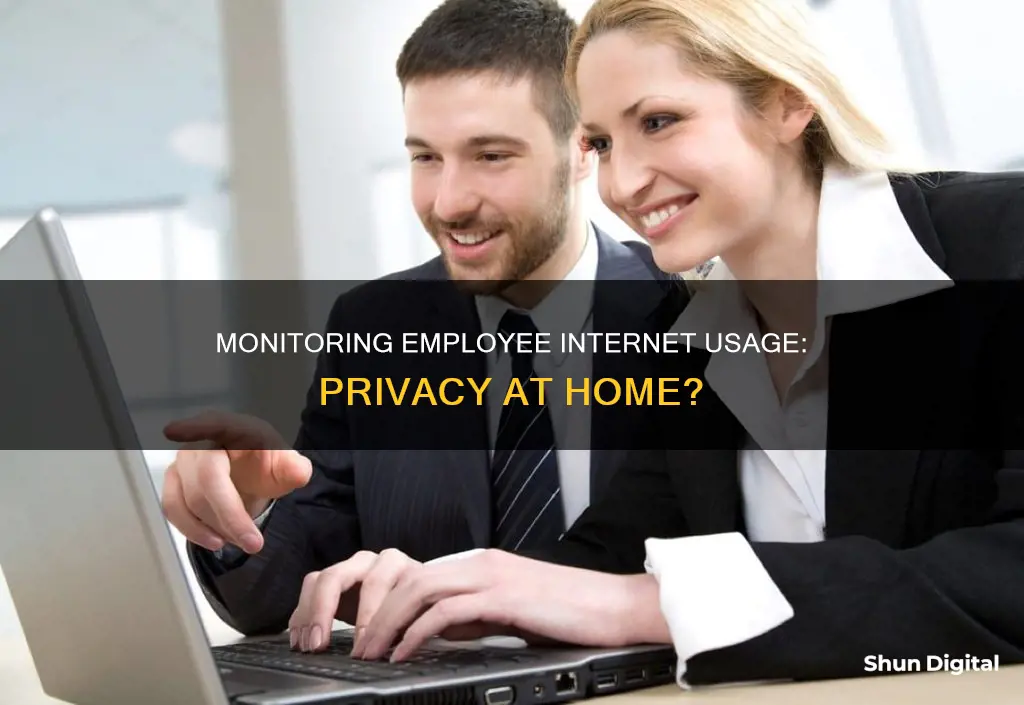
With the rise of remote working, employers are increasingly monitoring their employees' internet usage. This can be done in several ways, including the use of monitoring software, proxy servers, firewalls, and keylogging. Monitoring software can be installed on an employee's computer or network, capturing and logging data related to internet activities such as websites visited, time spent on each site, and emails. Proxy servers and firewalls can also be used to monitor and filter internet traffic.
While monitoring internet usage can help employers ensure compliance with company policies and improve productivity, it also raises significant privacy concerns and can lead to decreased morale and trust among employees. To address these concerns, employers should establish clear policies regarding internet monitoring, inform employees about monitoring practices, and respect privacy rights and legal regulations.
| Characteristics | Values |
|---|---|
| Type of monitoring | Internet surveillance, desktop surveillance |
| Software used | Time-tracking software, project management software, communication and collaboration tools, web and application monitoring, performance analytics, Network analyzers, Desktop surveillance software, Keyloggers, MDM software |
| Data collected | Websites visited, URLs accessed, time spent on each site, specific web pages viewed, file downloads and uploads, emails, chat messages, idle time |
| Data storage | On the employee's computer or a centralized server |
| Reporting and analysis | Reports on websites visited, time spent on different activities, productivity levels, and potential policy violations |
| Alerts and notifications | Alerts for specific activities or events, e.g. visiting prohibited websites |
| Legal considerations | Varies by jurisdiction; US law prohibits employers from intercepting emails in transit but allows reading before sending or after receiving; gathering of personal information like bank details is prohibited |
What You'll Learn

Time-tracking software
- Screenshots: Some time-tracking software takes screenshots at regular intervals or during specific tasks to monitor employee activity. This can help employers ensure that employees are using their time productively and not engaging in non-work-related activities.
- Activity levels: The software can track employee activity levels, such as keyboard and mouse usage, to determine if employees are actively working or idle.
- Idle time monitoring: By detecting periods of inactivity, employers can identify potential time-wasting behaviours and improve employee productivity.
- Reporting and analysis: Time-tracking software often includes reporting features that provide insights into employee productivity and efficiency. These reports can help employers make data-driven decisions about workload management and resource allocation.
- Alerts and notifications: Employers can set up alerts or notifications for specific activities, such as visiting prohibited websites or excessive idle time. This allows them to take prompt action to address any issues or violations.
It is important to note that employers should establish clear policies regarding internet monitoring and respect employee privacy rights. Transparent communication with employees about monitoring practices is essential to maintaining a positive work environment. Additionally, employers should ensure that their monitoring practices comply with legal requirements and regulations in their jurisdiction.
CenturyLink and Cox: Monitoring Your Internet Data Usage?
You may want to see also

Project management software
- Hubstaff: This software has solid employee monitoring features, including keystroke logging, URL and application monitoring, GPS and location monitoring, and more.
- Time Doctor: This software automatically records employees' app and internet activity, and generates reports to help employers track employees' time usage. It also includes a distraction management feature, which alerts employees when they visit unproductive websites.
- ActivTrak: This tool is focused on worker productivity and has improved capabilities for remote workers.
- DeskTime: This software has stellar time-tracking features and basic employee monitoring functions, such as URL and app tracking, private time for employees, and project and task management.
- VeriClock: This is a well-featured employee monitoring and time-tracking tool aimed at small to medium-sized businesses.
While these tools can help employers monitor employees' internet usage at home, it is important to note that there are potential drawbacks to employee monitoring. Some employees may feel uncomfortable being watched, which could lead to low morale and staff attrition. Additionally, productivity-monitoring efforts can sometimes backfire, with employees focusing on meeting quotas rather than activities that benefit the company. Therefore, employers should carefully consider the amount and type of monitoring they implement and ensure they have the consent of their employees to avoid legal issues.
Colleges Monitoring Student Online Activity: Is Privacy Invasive?
You may want to see also

Communication and collaboration tools
While these tools greatly facilitate communication and collaboration, they can also be used by employers to monitor employee internet usage and track employee communication, collaboration, and responsiveness. This monitoring can take several forms, including:
- Time tracking: Time tracking tools allow employees to log their work hours and the time spent on specific tasks or projects. These tools may also include features such as screenshots, activity levels, and idle time monitoring, providing employers with detailed insights into how employees are spending their time.
- Project management software: Platforms that help track the progress and status of tasks and projects can also be used to monitor employee productivity and efficiency. Managers can use these tools to oversee employee workloads, task completion rates, and project timelines, ensuring that employees are on track and utilising their time effectively.
- Web and application monitoring: Employers can use software to monitor the websites and applications accessed by employees during work hours. This can help ensure compliance with company policies and prevent unauthorised activities. For example, employers may block access to certain non-work-related websites or applications to improve focus and productivity.
- Performance analytics: Performance analytics tools go beyond simply tracking time and tasks by analysing employee productivity, efficiency, and output based on data collected from various sources. These tools can generate reports and insights to evaluate individual and team performance, helping employers identify areas where improvements can be made.
While the use of these tools can provide significant benefits to employers and employees alike, it is important to consider the potential ethical implications. Employees may feel that their privacy is being invaded, and monitoring activities must be carried out with transparency and respect for employee privacy rights. Employers should establish clear policies regarding internet and communication monitoring and ensure that employees are aware of and consent to these practices.
Monitoring Employee Internet Usage: Company Strategies and Tactics
You may want to see also

Web and application monitoring
The monitoring software captures and logs data related to employees' internet activities, including websites visited, URLs accessed, time spent on each site, and specific web pages viewed. It may also capture data on file downloads and uploads, emails, chat messages, and other online communications. This data is then stored securely, either on the employee's computer or on a centralized server managed by the employer.
Some monitoring software also allows employers to set up alerts or notifications for specific activities or events, such as visiting prohibited websites or excessive non-work-related browsing.
The use of web and application monitoring software can help employers address several challenges and benefits, including:
- Identifying productivity issues: Monitoring software can help employees avoid time-wasting websites or applications, improving their focus and productivity.
- Enforcing internet usage policies: By reviewing employees' browsing history, employers can ensure compliance with company policies and manage employees more effectively.
- Overseeing application usage: Monitoring software can track computer activity and internet use across various devices and networks, helping managers pinpoint inefficiencies and potential issues.
- Monitoring bandwidth consumption: Measuring bandwidth usage can help spot potential malware threats and network attacks.
- Protecting against viruses and hackers: Network monitoring can help deter hackers and detect malware attacks, allowing employers to take prompt action to protect their systems.
Medical Device Safety Compliance: Who Monitors Usage?
You may want to see also

Performance analytics
For example, if an employee is spending a lot of time on non-work-related tasks, such as social media or online shopping, performance analytics tools can identify this and help employers address the issue. Similarly, if an employee is consistently efficient and productive, this can be recognised and rewarded.
It is important to note that, while these tools can be beneficial, employers must balance protecting their interests with respecting employees' privacy rights. Transparency is key when implementing monitoring software, and employers should establish clear policies regarding internet monitoring.
Monitoring Electricity Usage: A Guide to Tracking Your Power Consumption
You may want to see also
Frequently asked questions
Yes, if your personal device is connected to the company network, your employer can monitor your activity. This can be done if your employer has installed monitoring software on your device or if they have access to your network.
Employers can monitor internet usage at home by using monitoring software, which can be installed on an employee's computer or network. This software can track and record various aspects of internet usage, such as websites visited, time spent on each site, and specific web pages viewed.
Monitoring internet usage can help employers identify productivity issues, enforce internet usage policies, oversee application usage, monitor bandwidth consumption, and protect against viruses or hackers.
Monitoring internet usage can raise significant privacy concerns and lead to decreased morale and trust among employees. It can also be technically complex to implement and manage, especially with remote workers and the use of personal devices.
Employers must navigate various laws and regulations regarding their ability to monitor employee internet usage, such as the General Data Protection Regulation (GDPR) in the European Union or state-specific privacy laws in the United States.







